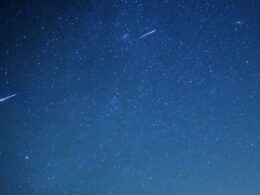Clouds are usually the bane of a stargazer’s life, hiding many celestial sights from view. But noctilucent clouds hold a special fascination because they lie on the edge of space and have an astronomical origin.

These night-shining clouds, are only seen in the mid-summer months from higher latitudes in both the northern and southern hemispheres. They appear with a beautiful shimmering glow, after the Sun has set and the sky has darkened.
Until recently scientists were not sure what caused these clouds, in one of the highest layers of Earth’s atmosphere, known as the mesosphere.
But today we know that they are produced when meteoric dust arrives from space and ice crystals form around this dust at higher northern or southern latitudes where the mesosphere is coldest. Industrial pollution may also produce the clouds.
Noctilucent clouds are often known by the shorthand term NLC. They are also sometimes referred to as mesospheric clouds, due to their location above us.

Noctilucent clouds are so high, at an altitude of around 80 km, or 50 miles, that they continue to catch the light from the Sun at midnight. They are sometimes confused with meteorological clouds, such as cirrus, but such weather clouds cannot glow in the night, and would instead be silhouetted against the twilit sky.
From northern latitudes above 50 degrees or so, night-shining clouds can be seen generally from May to August. During the rest of the year, the Sun sinks lower below the horizon and so is unable to illuminate the mesosphere.
They are usually seen over the northern horizon from northern hemisphere locations, though they can extend over more of the sky around summer solstice in June. Photos of them often show the brilliant star Capella too, since it is low over the northern horizon at this time of year.
In the southern hemisphere, the season for noctilucent clouds run from November to February at far southerly latitudes.

Though we know when noctilucent clouds may be seen, that does not mean they will be. Their appearance is unpredictable, and observers will just have to keep an eye on the night sky to see whether or not they appear.
Their appearance can change quite rapidly, and they can fade from view as swiftly as they appear. Astronomers classify them in five types of appearance, and any combination of these may be seen.
NLC forms are classified into 5 easily identified structures. Any combination of the following is possible…
- Type 1: Veil – A simple sheet of bright cloud, without visible structure.
- Type 2: Bands – Lines or streaks, which may be parallel or cross at small angles.
- Type 3: Waves – A fine herring-bone structure, like the ripples in the sky.
- Type 4: Whirls – Large-scale looped or twisted structures.
- Type 5: Amorphous – Isolated patches of NLC with no definite structure.
Excellent advice on how to observe noctilucent clouds can be found on the website of the Society for Popular Astronomy’s aurora section.
Related: What’s in the night sky this month?




